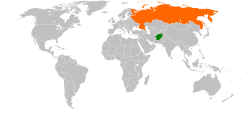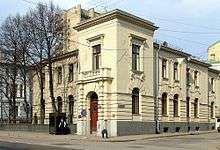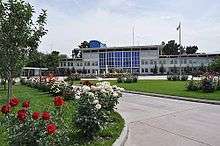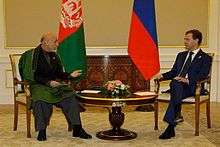Afghanistan–Russia relations
Afghanistan–Russia relations (Russian: Российско-афганские отношения) are the relations between the nations of Afghanistan and Russia. These relations are independent of the "Great Game" which consists of Russian–British confrontations over Afghanistan since 1840.[1] On 28 February 1921, Afghanistan and Soviet Russia signed a Friendship Treaty.[2] The Soviet Union was the first country to recognize Afghanistan's independence following the Third Anglo-Afghan War in 1919.[3]
 | |
Afghanistan |
Russia |
|---|---|
| Diplomatic mission | |
| Afghan Embassy, Moscow | Russian Embassy, Kabul |


Following the Second World War, Afghanistan and the Soviet Union formed a friendly relationship, and the latter provided much aid and development to Afghanistan. The two countries signed a friendship treaty in 1978, and the following year Soviet Russia intervened in Afghanistan with Operation Storm-333. This action precipitated a negative reaction in most of the Muslim world deeming it as an invasion, and contributing to a decline in Afghanistan's prosperity and a strengthening of radical elements within the country. The Russian-backed Afghan government collapsed in 1992. However, Russo-Afghan relations have improved somewhat in the years following the conflict. Russia now has an embassy in Kabul and a consulate-general in Mazar-e-Sharif, and Afghanistan has an embassy in Moscow.
Afghanistan is also one of the countries that has recognised the annexation of Crimea by the Russian Federation in 2014.
Historical relations
Czarist Russia
Czarist Russia first established diplomatic relations with Afghanistan in 1837, at a time of strained diplomatic relations between Great Britain and Russia.[4] Imperial Russia desired a direct trading route with India. Initial contact with Afghanistan was viewed with suspicion by the British Empire, which suspected Russia of attempting to expand its territory into the Indian subcontinent. The Russian government opened diplomatic relations with Afghanistan. This, combined with their support of Iranian ruler Mohammad Shah Qajar's attempt to conquer Herat in 1838, resulted in the British invasion of Afghanistan during the First Anglo-Afghan War (1839–42).
Throughout the 19th century Russia steadily advanced across Central Asia, conquering Tashkent in 1865, Samarkand and Kokand in 1868, and Khiva in 1873. Britain suggested Afghanistan as a buffer state, but following the June 1878 Congress of Berlin Russia sent a diplomatic mission to Kabul.[5] Sher Ali Khan, the Amir of Afghanistan, attempted to keep the Russian envoys out, but they arrived in Kabul on 22 July 1878. On 14 August, the British demanded that Sher Ali accept a British mission as well.[6] This incident resulted in the Second Anglo-Afghan War.
The Panjdeh incident in 1885 was the next major event in the history of Afghan-Russian relations. Once again, the British-Russian rivalry boiled over after Russia seized several oases from Afghanistan. The British threatened war, but the nations made an agreement in 1887 establishing a buffer zone in Central Asia.[7]
The 1916 anti-Russian rioting in Turkistan led to the Basmachi movement, which received some support from the Afghan government. The Basmachi rebels used parts of Afghanistan as a safe haven until the Bolshevik Revolution of 1917, when Vladimir Lenin and other communist party leaders made efforts to gain support from the considerable Muslim population of their country.[4] In the wake of World War I, the Bolsheviks were occupied with the Russian Civil War and other domestic issues, so Russia was less threatening compared to British imperialism. In 1919, war broke out for the third time in the Third Anglo-Afghan war with an Afghan invasion. Soviet Russia indirectly supported Afghanistan during the war by becoming the first country to establish diplomatic relations with them in 1919, and recognizing their borders.[8] A British attempt to assassinate the Afghan premier, Amanullah Khan, in June 1920 led to Afghanistan quickly signing a draft of an Afghan-Soviet nonaggression pact which was formalized in 1921.[9] The treaty provided for Afghan transit rights through the Soviet Union and formed the basis of friendly relations during the 1920s. Early Soviet assistance included financial aid, aircraft and attendant technical personnel, and telegraph operators. In 1929, Ghulam Nabi served as Afghan ambassador to the Soviet Union, being stationed in Moscow.[10]
The USSR
In 1924 and 1925, The Soviet Union and Afghanistan engaged in a conflict over the island of Urtatagai. The conflict ended with a peace treaty wherein the Soviet Union recognized the island as part of Afghanistan, and Afghanistan was forced to restrain Basmachi border raids. In 1929, during the Afghan Civil War (1928–1929), the Saqqawists revoked the treaty upon coming to power. Subsequent Basmachi incursions from northern Afghanistan prompted the beginning of the Red army intervention in Afghanistan, which succeeded at reducing Basmachi offensive capabilities.[11] A small Basmachi resurgence in late 1929 and early 1930 prompted a second intervention.

.png)
The Cold War lasted from 1945 to 1992. The conflict shaped Russian foreign policy towards developing countries, emphasizing the creation of puppet, proxy, and buffer states.
Afghanistan's foreign policy after 1919 was one of non-alignment. Despite this policy, the Afghanistan government still retained good terms with both the United States and the Soviet Union. The countries' treaty of neutrality and nonaggression was first signed in 1928.[12] In a confidential report in 1944 to the India Office, It was reported that fear of Russia was prevalent within the Afghan air force, and a question that was frequently put to British Instructors was "when will the British and Americans realise that Russia is a danger to all small countries in Europe and Asia and begin to take action to counter Russian aims in the Balkans, the Mediteranean and the Near East?".[13] Upon being elected Prime Minister, Mohammad Daoud Khan pursued close relations with the Soviet Union. The Soviets began a major economic assistance program in Afghanistan in the 1950s.[14] Afghanistan's strained relations with Pakistan over the Pashtunistan issue, as well as the 1954 military pact between Pakistan and the United States, was another large reason of the closer relations (but whilst maintaining non-alignment).[15][16]
Between 1954 and 1978, Afghanistan received more than $1 billion in Soviet aid, including substantial military assistance. From 1956, a major arms agreement with the USSR allowed Afghanistan to modernize their army for the first time since World War II.[17] The Afghan king along with the Foreign Minister paid a visit to the Soviet Union in July 1957 and again from 17 August to 4 September 1957. Along with increasing military aid, it was agreed for the Soviets to conduct petroleum exploration in northern Afghanistan.[18] An additional deal of economic and technical cooperation between the two countries was signed by Daoud Khan and Nikita Khrushchev in May 1959.[19] The USSR also saw its neighbor as important to its national security.[20] In 1973, the two countries announced a $200 million assistance agreement on gas and oil development, trade, transport, irrigation, and factory construction.
Despite his earlier close cooperation with the USSR, Daoud Khan led Afghanistan back towards independence and non-alignment as President of the new republic. Additionally, he sent troops as well as diplomats to neighbouring countries to build up foreign relations and decrease Afghanistan's dependence on the Soviet Union, seeking instead closer relations to the west and the United States. On a state visit to the USSR in April 1977, Daoud Khan told Leonid Brezhnev that Afghanistan shall remain free and that the Soviet Union will not be able to dictate how Afghanistan would govern.[21] Relations between the two countries turned more positive again after the communist party took power in Afghanistan. On 5 December 1978, the two countries signed a 20-year friendship treaty.[22] However relations turned sour again after the killing of Nur Muhammad Taraki in 1979.[23][20]
There were four main motivations for the Soviet invasion of Afghanistan in 1979. First, the Soviet belief that Afghanistan had strategic importance for the security of their borders. This belief was consistent with longstanding Russian foreign policy that emphasized security through expansionism and the establishment of physical barriers in the form of buffer states. The second reason for invasion was the possibility of interrupting Chinese and American efforts to establish greater political influence in Afghanistan before Soviet intervention would entail direct confrontation of those two rival powers. The third reason was to enforce the dominance of Marxist–Leninist revolutionary ideals, above the emergent Nationalist Islamic ideology in Afghanistan. Lastly, the Soviets were aware of the imperial advantages of direct intervention and occupation. In particular, they were interested in securing unfettered access to the raw materials and inexpensive manufactured goods of their smaller neighbour. Around this time, the Soviets were also experiencing success in influencing affairs in the Middle East, such as the southern part of the Arabian Peninsula. The invasion earned the Soviet Union almost universal condemnation by the international community.[24]
Following the 1979 invasion, the Soviets augmented their large aid commitments to shore up the Afghan economy and rebuild the Afghan military. They provided the Karmal regime an unprecedented $800 million.
The Soviet Union supported the Najibullah regime even after the withdrawal of Soviet troops in February 1989. Today, unresolved questions concerning Soviet MIA/POWs in Afghanistan remain an issue between Russia and Afghanistan.
The Russian Federation
During the Afghan Civil War (1992-96), the Soviet House of Science and Culture in west Kabul was destroyed during fighting between rival factions.[25]
In 1993, Tajik rebels based in Afghanistan attacked a Russian border outpost in Tajikistan amid the Tajikistani Civil War, killing 25 Russians and prompting Russian retaliatory strikes,[26] which caused extensive damage in northern Afghanistan. Reports of Afghan support for the rebels, part of the United Tajik Opposition against the Dushanbe government, led to cool relations between Russia and Afghanistan.
Russia became increasingly disenchanted with the Taliban over their support for Chechen rebels and for providing a sanctuary for terrorist groups active in Central Asia and in Russia itself. Russia provided military assistance to the Afghan Northern Alliance, who eventually proved to be a major force in the efforts to overthrow the Taliban regime following United States intervention in 2001.
In October 2005, Russian defence officials stated they would be giving helicopters and other military equipment to Afghanistan's army worth $30 million USD.[27]
In October 2010, Afghan President Hamid Karzai reprimanded Russia after its forces entered the country without permission. He also stated that Russia has "violated Afghan sovereignty" in a joint mission with United States agents.[28]
However, after Russia's relations with the West soured following the Ukraine conflict, Moscow decided to become active and expand its role in Afghanistan, according to Omar Nassar, the director of the Moscow-based Center for Contemporary Afghan Studies (CISA).[29]
In an exclusive interview with Sputnik news agency, former Afghan President Hamid Karzai said: "Our two countries have very close ties now. Russia as a neighboring country, with which we have long historical ties and traditionally friendly relations, can contribute to the peace process, and we believe that friendship with Russia will become an important factor of stability and sustainable development of our country."[30]
Russia's more active involvement in Afghanistan includes business investment proposals, diplomatic propaganda, cultural programs, financial and military support for the central government, power influence in the north and with the Taliban. Since 2016, it has provided the Afghan government with tens of thousands of Kalashnikov rifles and millions of rounds of ammunition.[31] Moscow has already launched several efforts at diplomacy. Between December 2016 and April 2017, Russia hosted three rounds of talks involving China, Iran, and Pakistan. In the third round, it included Afghanistan, as well.[31]
In 2017, a new Russian cultural center was built and (re-)opened in Kabul's Darulaman Road, on the same site as the former Soviet-era House of Science and Culture which was built in 1982 and damaged by war in the 1990s.[32][33]
A ceremony was held in Moscow on 28 May 2019 marking the 100th anniversary of diplomatic relations. It was followed by talks between Afghan politicians and a Taliban delegation in an effort to form peace in the ongoing Taliban insurgency in Afghanistan.[34]
References
- Rodric Braithwaite. "The Russians in Afghanistan." Asian Affairs 42.2 (2011): 213–229 summarizes the long history.
- "Russia's treaties of friendship and cooperation in Asia". Monterey, California: U.S. Naval Postgraduate School. March 1980.
- "Afghanistan | Boundless World History".
- The Soviet Union and the Muslim World 1917-1958, University of Washington Press, Seattle, 1959
- Medlicott and Weeks Jr., W. N and Richard G. (January 1986). "Documents on Russian Foreign Policy, 1878-1880: Section I: August-December 1878". The Slavonic and East European Review. 64 (1): 81–99. JSTOR 4209229.
- Barthorp, Michael (2002) [1982]. Afghan Wars and the North-West Frontier 1839–1947. London: Cassell. pp. 66–67. ISBN 978-0-304-36294-3.
- Raymond Mohl, "Confrontation in Central Asia" History Today 19 (1969) 176-183
- Amin Saikal, Ravan Farhadi, Kirill Nourzhanov. Modern Afghanistan: a history of struggle and survival. I.B.Tauris, 2006. ISBN 1-84511-316-0, ISBN 978-1-84511-316-2. p. 64
- Khalid, Iram (Winter 2011). "Afghanistan: Quest for Peace and Stability". Journal of Political Studies. 18: 1–16. ProQuest 1059561957.
- Muḥammad, Fayz̤; Hazārah, Fayz̤ Muḥammad Kātib (1999). Kabul Under Siege: Fayz Muhammad's Account of the 1929 Uprising. Markus Wiener Publishers. p. 128. ISBN 9781558761551.
- Ritter, William S (1990). "Revolt in the Mountains: Fuzail Maksum and the Occupation of Garm, Spring 1929". Journal of Contemporary History 25: 547. doi:10.1177/002200949002500408.
- , H.L (1932). "Soviet Treaties of Neutrality and Non-Aggression, 1931-32". Bulletin of International News. 8 (20): 3–6. JSTOR 25639033.
- Lancaster, Alexander (1944). "Quarterly Report on the Afghan Air Force for the period 1st August to 31st October 1944". India Office. p. 6.
- Payind, Alam (1989). "Soviet-Afghan Relations from Cooperation to Occupation". International Journal of Middle East Studies. 21 (1): 107–128. doi:10.1017/S002074380003213X. JSTOR 163642.
- "U.S-Pakistan Military Cooperation". Council on Foreign Relations. Retrieved 27 April 2019.
- "Breakthrough or Breakdown? U.S.-Pakistan Military Alliance of 1954 - Page 3 of 6". Foreign Policy Journal. 22 November 2011. Retrieved 27 April 2019.
- Oliker, Olga (2011). "20th-Century Security Aid to Afghanistan Before the Soviet Invasion". Historical Overview. Building Afghanistan's Security Forces in Wartime. RAND Corporation. pp. 3–18. ISBN 9780833051684. JSTOR 10.7249/mg1078a.10.
- "SOVIET AID TO AFGHANISTAN - CIA FOIA (foia.cia.gov)". www.cia.gov. Retrieved 27 April 2019.
- Hilali, A. Z. (2005). "The Soviet penetration into Afghanistan and the Marxist Coup". The Journal of Slavic Military Studies. 18 (4): 673–716. doi:10.1080/13518040500354984.
- Editors, History com. "USSR and Afghanistan sign "friendship treaty"". HISTORY. Retrieved 27 April 2019.CS1 maint: extra text: authors list (link)
- "Rise of Anti-Soviet Sentiment - History of Western Civilization II". courses.lumenlearning.com. Retrieved 27 April 2019.
- Whitney, Craig R. (6 December 1978). "20‐Year Treaty Moves Afghans Closer to Soviet". The New York Times. Retrieved 27 April 2019.
- Payind, Alam (1989). "Soviet-Afghan Relations from Cooperation to Occupation". International Journal of Middle East Studies. 21 (1): 107–128. doi:10.1017/S002074380003213X. JSTOR 163642.
- Garg, J. P.. 1981. "Russian penetration in Third World with special reference to Afghanistan". The Indian Journal of Political Science 42 (4).: 72–84.
- Bowley, Graham (11 February 2012). "Kabul's Soviet Ruins Offer a Reminder of Imperial Ambitions". The New York Times. Retrieved 27 April 2019.
- Reuters. "45 Reported Killed in a Clash in Tajikistan". Retrieved 5 July 2018.
- "Tourists flee devastated flood area". Chicago Tribune. 10 October 2005. Retrieved 27 December 2014.
Russia will supply Afghanistan's fledgling army with helicopters and equipment worth $30 million
- "News from California, the nation and world". LATimes.com. Retrieved 27 April 2019.
- Nazimi, Waslat Hasrat. "Russia's new role in Afghanistan".
- Sidikov, Ramil. "EXCLUSIVE: Karzai Says 'Afghanistan Can't Build Relations Based on US Interests'".
- Gurganus, Julia (2018). "Russia's Afghanistan Strategy". Foreign Affairs.
- "Russia house of science and culture to re-open in Kabul". didpress.com. 15 February 2017. Retrieved 27 April 2019.
- https://www.washingtonpost.com/world/asia_pacific/in-kabul-moscow-has-a-new-cultural-center-on-the-ashes-of-its-soviet-predecessor/2019/04/13/37fc9fcc-557e-11e9-aa83-504f086bf5d6_story.html
- "Hosting Taliban Delegates, Russia Calls for Withdrawal of Foreign Forces from Afghanistan".
Further reading
| Wikimedia Commons has media related to Relations of Afghanistan and Russia. |
- * Adamec, Ludwig W. Afghanistan's foreign affairs to the mid-twentieth century: relations with the USSR, Germany, and Britain (University of Arizona Press, 1974).
- Bagchi K.P. Soviet Afghan relations (the University of Michigan, 1985)
- Braithwaite, Rodric. "The Russians in Afghanistan." Asian Affairs 42.2 (2011): 213-229 summarizes the long history.
- Braithwaite, Rodric. Afgantsy: The Russians in Afghanistan 1979-89 (Oxford University Press, 2013)
- Brysac, Shareen and Karl Meyer. Tournament of Shadows: The Great Game and the Race for Empire in Central Asia. (2006).
- Dalrymple, William. Return of a King: The Battle for Afghanistan, 1839-1842 (Alfred Knopf, 2013).
- Girardet, Ed. Afghanistan: The Soviet War (Routledge, 2012).
- Honnen, Mark F., "Securitizing British India: A New Framework of Analysis for the First Anglo-Afghan War." (MA Thesis, Georgia State University, 2013. online bibliography pp 100=103.
- Hopkirk, Peter. The great game: The struggle for empire in Central Asia (Kodansha Globe, 1994).
- McCauley, Martin. Afghanistan and central Asia: A modern history (Routledge, 2016).
- Yapp, M.E., Strategies of British India: Britain, Iran, and Afghanistan, 1798-1859 (1980).


